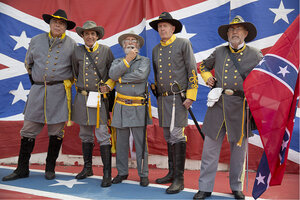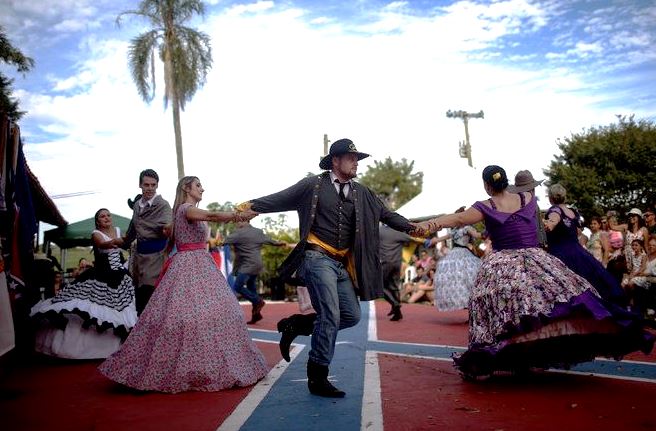Latin America
Related: About this forumArchaeologists Discover Wreckage of Notorious Slave Ship Off Brazil
BY FRANCESCA ATON
July 13, 2023 2:52pm

Illustration of an Atlantic slave trade or transatlantic slave trade ship that took place across the Atlantic Ocean from the 16th through to the 19th centuries.
PHOTO PICTURES FROM HISTORY/UNIVERSAL IMAGES GROUP VIA GETTY IMAGES
The wreckage of a 19th-century U.S. ship with more than 500 slaves on board may have been identified by archaeologists in the sea of Angra dos Rei, Brazil, according to the local news outlet TV Prefeito.
Though researchers are still investigating, they believe it was a North American ship led by slave trader Nathanial Gordon, who was en route to deliver 500 enslaved Africans from Mozambique to Bracuí in Angra dos Reis in 1851.
Gordon illegally participated in the slave trade to Brazil, for which he was later tried, convicted, and executed under the Piracy Law of 1820.
. . .
Brazil was built on the enslavement of millions of Africans and Indigenous peoples. Research conducted by Princeton University observes that, “Of the 12 million enslaved Africans brought to the New World, almost half—5.5 million people—were forcibly taken to Brazil as early as 1540 and until the 1860s.”
More:
https://www.artnews.com/art-news/news/archaeologists-discover-wreckage-of-notorious-slave-ship-off-brazil-1234674088/
Vogon_Glory
(9,765 posts)Twenty three years AFTER slavery was abolished in the United States.
OT Slavery was abolished in Spanish Cuba in 1886.
Judi Lynn
(163,257 posts)The Confederacy Made Its Last Stand in Brazil
After the Civil War, more than 10,000 Southerners left the U.S. rather than submit to Yankee rule.
BY: JESSE GREENSPAN
UPDATED: JUNE 22, 2020 | ORIGINAL: JULY 25, 2018
By the time the Civil War ended in 1865, much of the South lay in ruins, physically, economically and socially. Fears of Yankee reprisals and racial conflict percolated through society. Enslaved people had been freed; Confederate President Jefferson Davis was imprisoned. For William H. Norris, a former Alabama state senator and staunch Confederate, it was all too much to bear.
Rather than rejoin the United States, he and a son traveled to southeastern Brazil in late 1865 and purchased about 500 acres of rolling hills and reddish soil that reminded them of Alabama. They then bought three enslaved workers, planted cotton, sent for the rest of the family and proceeded to live as if the Confederacy hadn’t just collapsed.
The Norris family was not alone in their desire to avoid Yankee rule. In the decade after the Civil War, roughly 10,000 Southerners left the United States, with the majority going to Brazil, where slavery was still legal. (Others went to such places as Cuba, Mexico, Venezuela, Honduras, Canada and Egypt.) Though hardships prompted most to come right back, descendants of these so-called Confederados maintain a presence in Brazil even today.
Amid the post-Civil War chaos, several countries tried to entice Southerners, largely for political and agricultural reasons. In Mexico, for example, Emperor Maximilian I (soon to be executed before a firing squad) awarded land and tax breaks and hired Confederate oceanographer Matthew Fontaine Maury to be his “imperial commissioner of immigration.” In Venezuela, the authorities also provided land and tax breaks. And in Egypt, an Ottoman viceroy brought over ex-Confederate and ex-Union officers to help invade Ethiopia.
The best incentives, however, came from Brazilian Emperor Dom Pedro II, a Confederate ally who had sheltered and supplied Southern ships during the Civil War. He offered land to the Confederados for as little as 22 cents an acre, subsidized their transport to Brazil, provided temporary lodging upon arrival, promised them quick citizenship and, at times, even personally greeted them as they disembarked.
More:
https://www.history.com/news/confederacy-in-brazil-civil-war
~ ~ ~
New law could mark end of American Confederacy – in Brazil

By Sage Behr Contributor
Zach Ben-Amots Contributor
August 16, 2022
|
SANTA BÁRBARA D’OESTE, BRAZIL
The Cemitério do Campo is unlike any other cemetery in Brazil. Located at the end of a dirt road in rural São Paulo state, it’s the site of an estimated 500 graves, a small ecumenical chapel – and one of the world’s largest Confederate flags.
Settled by Confederates fleeing their loss in the U.S. Civil War more than 150 years ago, it’s been host to the Festa Confederada, or Confederate Festival, for the past four decades. Thousands travel from across Brazil to celebrate the legacy of the Confederate States of America, complete with flags and a country music soundtrack. Attendees use “Confederate dollars” to buy chicken and biscuits, while watching reenactments from the antebellum South.
But a new municipal law could mean the end of the annual celebration and any other public event commemorating the Confederacy. The ordinance bans the use of racist symbols at public festivals, and the Confederate flag and this festival in Santa Bárbara d’Oeste are specifically named in the justification for the law, which passed last month with near-unanimous support.
The conflict here mirrors the ongoing debate over Confederate symbols and monuments in the United States, despite taking place thousands of miles south of the Mason-Dixon Line. For residents, however, it’s a hyperlocal dispute about representation and balancing the legacy of slavery in Brazil with the unusual story of American immigrants who settled in this small town a century and a half ago.
The law’s passage has raised the stakes on how this unique history should best be honored. While some are doubling down on the importance of the Confederate flag, others are using the ordinance as an opportunity to give new voice to often-overlooked narratives in Santa Bárbara d’Oeste. How the city identifies a middle ground between remembering the past and recognizing the weight of historic symbols could serve as a road map for other hot-button issues vexing an increasingly polarized Brazil in the future.
More:
https://www.csmonitor.com/World/Americas/2022/0816/New-law-could-mark-end-of-American-Confederacy-in-Brazil




~ ~ ~
Wikipedia:
Confederados (Portuguese pronunciation: [kõfedeˈɾadus]) is the Brazilian name for Confederate expatriates who fled the Southern United States during Reconstruction, and their Brazilian descendants. They were enticed to Brazil by offers of cheap land from Emperor Dom Pedro II, who had hoped to gain expertise in cotton farming.
It is estimated that up to 20,000 American Confederates immigrated to the Empire of Brazil from the Southern United States after the American Civil War. Initially, most settled in the current state of São Paulo, where they founded the city of Americana, which was once part of the neighboring city of Santa Bárbara d'Oeste. The descendants of other Confederados would later be found throughout Brazil.
The center of Confederado culture is the Campo Cemetery in Santa Bárbara d'Oeste, where most of the original Confederados from the region were buried. Because of their Protestant religion, they could not be buried in a Catholic cemetery, so they created their own cemetery, the first non-Catholic, non-indigenous cemetery in Brazil. The Confederado community has also established a Museum of Immigration at Santa Bárbara d'Oeste to present the history of Brazilian immigration and highlight its benefits to the nation.
The descendants still foster a connection with their history through the Fraternity of American Descendants, an organization dedicated to preserving the unique mixed culture. Os Confederados also have an annual festival, called the Festa Confederada, which is used to fund the Campo Cemetery. The festival is marked by Confederate flags, traditional dress of Confederate uniforms and hoop skirts, food of the American South with a Brazilian flair, and dances and music popular in the American South during the Antebellum period.
More:
https://en.wikipedia.org/wiki/Confederados
~ ~ ~
Cuba and the United States in the Atlantic Slave Trade (1789–1820)
Co-directors: Marial Iglesias Utset, Jorge Felipe Gonzalez (Michigan State University)
This project explores the extent to which the vertiginous growth of the slave trade based in Havana after 1808 was driven by the transfer of human and financial capital and expertise accumulated in the slave trade. After its abolition in the United States, American dealers redirected their investments to Cuba. Driven by the sustained boom in sugar and coffee in Cuba and the rising strength of the cotton market in the southern United States, a large group of American merchants joined forces with traders and planters in Havana. The results had long-term repercussions: Cuba became the largest slave colony in all of Hispanic America, with the highest number of enslaved persons imported and the longest duration of the illegal slave trade. About 800,000 slaves were imported to Cuba—twice as many as those shipped to the United States. Between 1808 and 1820, when the legal trafficking of slaves in Cuba ceased, the Spanish flag sheltered many American slave trade expeditions and the networks between American and Cuban merchants as well as the West African factors were consolidated. This Atlantic Slave Trade Project seeks to elucidate the ways in which the slave traders of Cuba created and consolidated a powerful infrastructure and a prominent position in the nineteenth-century Atlantic slave trade. It builds on archival sources in Cuba and the United States and is embedded in the theoretical and methodological framework of Atlantic history.
https://hutchinscenter.fas.harvard.edu/cuba-us-slave-trade
Vogon_Glory
(9,765 posts)Last edited Mon Jul 17, 2023, 03:30 PM - Edit history (1)
I am not booking tickets for that guilt trip. Those people might look like white Southerners, they might have Southern white ancestors, but they are BRAZILIANS.
I do not excuse the participation of Americans in the international slave trade before 1865 and slavery prior to Juneteenth, but those Confederado folks packed their bags and became foreigners. It is now roughly 140 years since they left American soil. The Confederate emigres’ descendants in Brazil are Brazilians. It is their problem, for THEM to sort out.